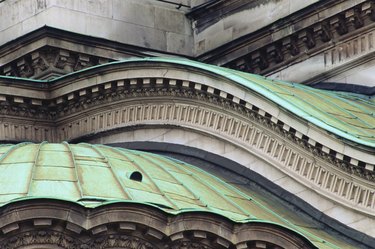
Copper normally changes in appearance from a shiny, red metal to a dull green. This change occurs as a result of a chemical reaction between the copper, moisture and oxygen, referred to as oxidation. Copper can also turn gray, brown or blue in some circumstances. The only way to prevent a copper roof from turning green is to prevent this reaction from occurring. It would be inconvenient to regularly clean a roof to prevent it from oxidizing, a common method of preventing household items made of copper from oxidizing, so a more long-term form of protection is needed.
Roof Issues
Video of the Day
A copper roof is one of the worst possible situations for copper turning green. Oxygen and copper do not react very quickly by themselves, but adding water to these two elements causes them to react more quickly. There is no realistic way to prevent a roof from being hit by rain, so the presence of water is going to occur. In addition, rain is naturally slightly acidic, which also causes the reaction to occur more quickly. The standard method of preventing copper from changing color is regular cleaning, but the size and location of the roof can make this an impractical option.
Video of the Day
Prevention
The most effective way to stop oxidation from occurring is to prevent the chemicals needed to cause the reaction from coming into contact with the copper itself. The best method for this is by applying a clear coat.
Applying a Clear Coat
The clear coat used to prevent a roof from turning green should be one specifically marked for copper. However, the roof needs to be cleaned before applying the clear coat, even if it does not appear to be dirty. You should also cover up as much exposed skin as possible, including wearing gloves, to prevent the oils from your skin being deposited on the roof. These oils can prevent the clear coat from properly bonding to the surface. A solvent cleaner, such as xylene or denatured alcohol, should be used to clean off the entire roof to remove any oils or contaminants present. Once the roof is cleaned, the clear coat is applied to the entire surface. Some clear coats are sprayed onto the roof using a spray can, while others are painted onto the surface. The clear coat needs to be reapplied every few years, but the exact length of time can vary by a year or two based on the brand of clear coat and the outdoor conditions.
Clear Coat Issues
The clear coat may not function properly to prevent a copper roof from turning green. Using a clear coat not intended for copper is one major issue. Clear coats for other applications might not prevent the oxidation reaction from occurring at all. In addition, it is possible the clear coat itself might cause a reaction with the copper. Neither of these pose an issue with clear coats made for copper. Oils left on the roof can also pose a problem. The oil can prevent the clear coat from bonding correctly over some sections of the roof, resulting in patches of copper that are oxidizing even if the rest of the roof is fine.